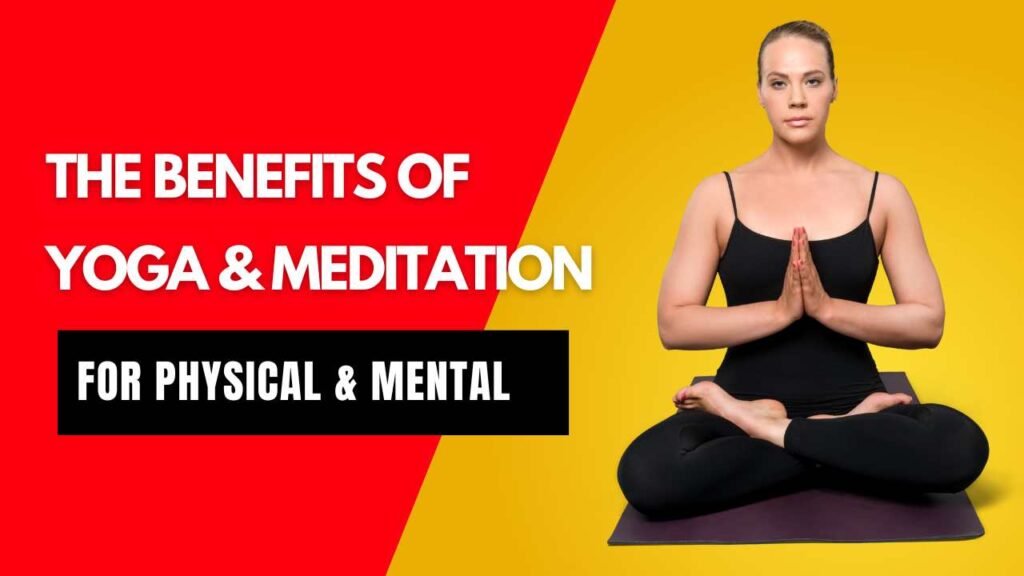Yoga and meditation have been practiced for thousands of years and are widely recognized for their numerous benefits to both physical and mental health. Incorporating these practices into your daily routine can lead to significant improvements in well-being, stress reduction, and overall quality of life. This guide explores the key benefits of yoga and meditation, highlighting how they can positively impact various aspects of health.
Physical Health Benefits of Yoga
1. Improves Flexibility and Balance
Enhanced Flexibility: Yoga involves various poses and stretches that gradually increase flexibility, making it easier to perform daily activities and reducing the risk of injury.
Better Balance: Many yoga poses require balance and coordination, which can improve stability and prevent falls, especially in older adults.
2. Strengthens Muscles
Muscle Toning: Yoga incorporates body-weight exercises that strengthen and tone muscles, promoting overall body strength without the need for heavy weights.
Core Strength: Many yoga poses target the core muscles, enhancing stability, posture, and balance.
3. Boosts Cardiovascular Health
Heart Health: Certain types of yoga, such as Vinyasa and Ashtanga, provide cardiovascular benefits by increasing heart rate and improving circulation.
Blood Pressure Regulation: Regular yoga practice can help lower blood pressure and improve heart rate variability, reducing the risk of cardiovascular disease.
4. Enhances Respiratory Function
Breathing Techniques: Yoga includes pranayama, or breath control exercises, which improve lung capacity, respiratory efficiency, and overall oxygen intake.
Stress Reduction: Controlled breathing techniques can reduce stress and anxiety, promoting a sense of calm and relaxation.
5. Aids in Weight Management
Calorie Burn: Active forms of yoga, such as Power Yoga, can burn calories and contribute to weight loss and weight maintenance.
Mindful Eating: Yoga encourages mindfulness, which can lead to healthier eating habits and a better relationship with food.
Mental Health Benefits of Yoga and Meditation
1. Reduces Stress and Anxiety
Stress Relief: Both yoga and meditation activate the parasympathetic nervous system, promoting relaxation and reducing the physiological effects of stress.
Anxiety Management: Mindfulness practices in yoga and meditation help manage anxiety by encouraging present-moment awareness and reducing overthinking.
2. Improves Mood and Emotional Well-being
Mood Enhancement: Regular practice of yoga and meditation increases the production of neurotransmitters like serotonin and dopamine, which are associated with feelings of happiness and well-being.
Emotional Balance: These practices help regulate emotions, leading to greater emotional stability and resilience in the face of life’s challenges.
3. Enhances Cognitive Function
Focus and Concentration: Meditation, in particular, improves attention span and concentration by training the mind to focus on a single point of attention.
Memory Improvement: Studies have shown that meditation can enhance memory and cognitive function by increasing gray matter in the brain.
4. Promotes Better Sleep
Sleep Quality: Yoga and meditation can improve sleep quality by reducing stress, promoting relaxation, and helping regulate sleep patterns.
Insomnia Relief: Practices such as yoga nidra (yogic sleep) and mindfulness meditation can be particularly effective in alleviating insomnia and promoting restful sleep.
5. Increases Self-awareness and Mindfulness
Self-awareness: Yoga and meditation encourage self-reflection and a deeper understanding of oneself, fostering personal growth and self-awareness.
Mindfulness: These practices cultivate mindfulness, helping individuals live more fully in the present moment and appreciate the here and now.
Integrating Yoga and Meditation into Your Routine
Start Slowly: If you are new to yoga or meditation, start with short sessions and gradually increase the duration and intensity as you become more comfortable.
Find a Style That Suits You: Explore different styles of yoga (e.g., Hatha, Vinyasa, Yin) and meditation (e.g., mindfulness, loving-kindness, body scan) to find what resonates best with you.
Consistency is Key: Aim to practice regularly, even if it’s just a few minutes each day. Consistency will yield better results over time.
Create a Calm Environment: Set up a peaceful, distraction-free space for your yoga and meditation practice to enhance the experience.
Seek Guidance: Consider attending classes or using online resources and apps to learn proper techniques and stay motivated.
Conclusion
Yoga and meditation offer a wealth of benefits for both physical and mental health. From improving flexibility, strength, and cardiovascular health to reducing stress, enhancing mood, and boosting cognitive function, these practices can transform your overall well-being. By incorporating yoga and meditation into your daily routine, you can cultivate a healthier, more balanced, and fulfilling life.
FAQ on Yoga and Meditation
Q1: How often should I practice yoga and meditation to see benefits? A1: Even a few minutes of daily practice can be beneficial. Aim for at least 20-30 minutes of yoga and/or meditation several times a week for more significant results.
Q2: Can I practice yoga and meditation if I have a medical condition? A2: Yes, but it’s important to consult with your healthcare provider before starting any new exercise regimen. Many forms of yoga and meditation can be adapted to accommodate various health conditions.
Q3: Do I need any special equipment for yoga? A3: Basic yoga practice requires minimal equipment—typically a yoga mat. Props like blocks, straps, and bolsters can be helpful, but they are not essential for beginners.
Q4: Can yoga and meditation help with chronic pain? A4: Yes, yoga and meditation can help manage chronic pain by improving physical function, reducing stress, and promoting relaxation. Practices such as gentle yoga and mindfulness meditation are particularly effective.
Q5: What is the best time of day to practice yoga and meditation? A5: The best time to practice is whenever you can consistently fit it into your schedule. Many people prefer morning practice to start the day with focus and energy, while others find evening practice helps them unwind and relax before bed





